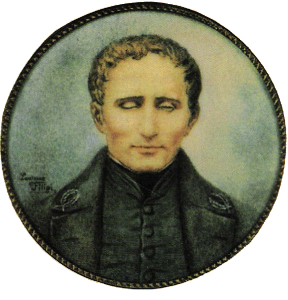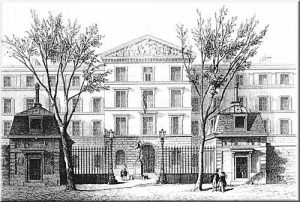Braille is one of the most important inventions in human history. Unfortunately, this invention is often forgotten, as is its inventor, Louis Braille, who is not widely known. As a result, many of us have no idea why the letter was invented and what impact the discovery of this letter had on education for the blind.
Blindness
Louis Braille was born on January 4, 1809, in Cupfrey, a small village 32 kilometers from Paris. He is the youngest of 4 children, son of Simon-Rene´Braille and Monique Baron.
Louis was not born blind; he only started going blind when he was 3 years old. One day, while he was playing, he held a leather rope in his right hand and a machete in his left. The knife accidentally pierced his right eye, and the medical knowledge of the time could not save him.

Meanwhile, Lewis’ left eye became inflamed, apparently at a late stage of sympathetic ophthalmia, causing vision loss. It is unclear how long the inflammatory process lasted, but by the age of 5, Louis was completely blind.
Luckily for Louis, though, his family was not wealthy, but they were well educated, and took care of their children’s education.
At the age of 10, young Louis was sent to the Royal Academy of Youth in Paris. At this school, 100 blind people attend boarding schools.
The school’s educational system is based on learning to read the letters of the cast alphabet by touch. This mode of learning was developed by Valentine Hauy (1745-1822), the first blind teacher. The goal is to enable blind students to read by recognizing embossed letters by touch.
Unfortunately, the results using this learning system are not very good. Abbot Caton, director of the Bruges School for the Blind, reported in 1837 that only three or four blind people could read and write in Paris. In addition, the school offers only 14 books in embossed letters.
Invention of Braille
At the Royal Academy of Youth Academy, Louis Braille was known as an excellent student of intellectual tasks and manual skills. In addition, he is also known for his talent for playing musical instruments. On August 8, 1828, Louis Braille became a re’pe’titeur, the equivalent of a school apprentice.

The story of the invention of Braille begins with the visit of Charles Barbier, a retired artillery captain from Napoleon’s army, to the institute to demonstrate his discovery of a code system used by soldiers to send messages to each other in complete darkness through a system of dots representing sound.
Blind students took part in the demonstration, and there’s no denying the system is easier to understand than Hauy’s.
But the system Barbier introduced was still too complicated for students because it wasn’t designed for them. It is nearly impossible to memorize the 4,069 different combinations of Barbier’s 12 letter dots.
Louis, who was 12 at the time, was very interested in haircutting systems. To this end, he worked hard to improve and perfect the system. A year later, he managed to create his own code, which he thought was better and easier to learn than Barbier’s.
By October 1824, when Louis was only 15 years old, he had improved his code system for effective use. Instead of tones, his method used a combination of raised dots that represented the actual letters of the alphabet.
Braille codes use fewer dots, making them easier to learn, and the patterns are small enough to fit under a fingertip, making the dots faster to read. The letter consists of six points and 64 possibilities. In this way, blind people can learn to spell and read the same letters as sighted people.
The Braille system was quickly adopted by many other blind students in the school. However, most visible teachers refuse to learn Braille forms that they find too difficult.
Another student then contacted the French government to ask it to recognize Braille as the official reading system for the blind. But neither the agency nor the national government is overly enthusiastic about Braille innovation.
Although Braille had the opportunity to demonstrate its system to King Louis-Philippe I in 1834, it still struggled to gain government approval.
Not all great inventions end in glory, and Louis Braille was one of them. During his fight for official recognition, he contracted tuberculosis. This disease led to his death on January 6, 1852.
He died without getting official recognition for his invention, there was no widespread appreciation of the use of Braille, only a handful of his close friends did.
In 1854, two years after Braille’s death, the French government finally approved the coinage point system that came to be known as Braille. When representatives of most European countries met at the World Congress of the Blind in 1858, they voted to make Braille the world’s standard system for reading and writing.
Bibliography
Bullock JD, Galst JM. “The Story of Louis Braille”. Arch Ophthalmol. 2009;127(11):1532–1533.
Farell, Gabriel. The Story of Blindness. Cambridge: Harvard University Press, 1956.
Jimenez, Javier, dll. “Biography of Louis Braille and Invention of the Braille Alphabet.” Survey of Ophthalmology, Vol. 54 No. 1, 2009.
Morse, Alan R. “Valentin Haüy and Louis Braille: Enabling Education for the Blind.” Dalam Michael F. Marmor, (Ed.), Foundations of Ophthalmology. New York: Springer, 2017.